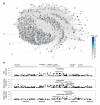A trans-acting locus regulates an anti-viral expression network and type 1 diabetes risk
- PMID: 20827270
- PMCID: PMC3657719
- DOI: 10.1038/nature09386
A trans-acting locus regulates an anti-viral expression network and type 1 diabetes risk
Abstract
Combined analyses of gene networks and DNA sequence variation can provide new insights into the aetiology of common diseases that may not be apparent from genome-wide association studies alone. Recent advances in rat genomics are facilitating systems-genetics approaches. Here we report the use of integrated genome-wide approaches across seven rat tissues to identify gene networks and the loci underlying their regulation. We defined an interferon regulatory factor 7 (IRF7)-driven inflammatory network (IDIN) enriched for viral response genes, which represents a molecular biomarker for macrophages and which was regulated in multiple tissues by a locus on rat chromosome 15q25. We show that Epstein-Barr virus induced gene 2 (Ebi2, also known as Gpr183), which lies at this locus and controls B lymphocyte migration, is expressed in macrophages and regulates the IDIN. The human orthologous locus on chromosome 13q32 controlled the human equivalent of the IDIN, which was conserved in monocytes. IDIN genes were more likely to associate with susceptibility to type 1 diabetes (T1D)-a macrophage-associated autoimmune disease-than randomly selected immune response genes (P = 8.85 × 10(-6)). The human locus controlling the IDIN was associated with the risk of T1D at single nucleotide polymorphism rs9585056 (P = 7.0 × 10(-10); odds ratio, 1.15), which was one of five single nucleotide polymorphisms in this region associated with EBI2 (GPR183) expression. These data implicate IRF7 network genes and their regulatory locus in the pathogenesis of T1D.
Figures



References
-
- Honda K, et al. IRF-7 is the master regulator of type-I interferon-dependent immune responses. Nature. 2005;434:772–777. - PubMed
-
- Gatto D, Paus D, Basten A, Mackay CR, Brink R. Guidance of B cells by the orphan G protein-coupled receptor EBI2 shapes humoral immune responses. Immunity. 2009;31:259–269. - PubMed
-
- Schadt EE. Molecular networks as sensors and drivers of common human diseases. Nature. 2009;461:218–223. - PubMed
Publication types
MeSH terms
Substances
Grants and funding
LinkOut - more resources
Full Text Sources
Other Literature Sources
Medical
Molecular Biology Databases

